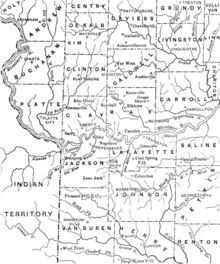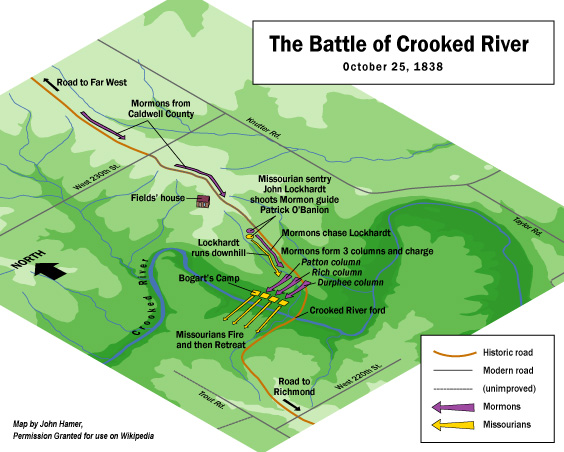Battle of Crooked River
This article includes a list of general references, but it lacks sufficient corresponding inline citations. (June 2022) |
39°29′50.45″N 94°7′36.96″W / 39.4973472°N 94.1269333°W
| Battle of Crooked River | |||||||
|---|---|---|---|---|---|---|---|
| Part of Missouri Mormon War and Mormon Wars | |||||||
 A painting of the Battle of Crooked River, October 24th 1838 | |||||||
| |||||||
| Belligerents | |||||||
| Mormon forces | Missouri state militia | ||||||
| Commanders and leaders | |||||||
| David W. Patten† |
David Rice Atchison Samuel Bogart | ||||||
| Strength | |||||||
| Unknown | 1 company | ||||||
| Casualties and losses | |||||||
| 3 killed, 8 wounded[1] | 1 killed, 1 wounded | ||||||
The Battle of Crooked River was a skirmish between Mormon forces and a Missouri state militia unit from southeast of Elmira, Missouri, in Ray County; the militia unit was under the command of Samuel Bogart. The battle was one of the principal points of conflict in the 1838 Missouri Mormon War. After the battle, the governor of Missouri issued Missouri Executive Order 44, sometimes called the "Extermination Order", which led to the expulsion of the Mormons from Missouri.
Background[edit]
Ray County was located immediately south of the Mormon-dominated Caldwell County. The two counties were separated by a no-man's land 24 miles long and 6 miles wide, known as "Bunkham's Strip" or "Buncombe Strip". This unincorporated strip was attached to Ray County for administrative and military purposes.

In early 1838, a group of prominent leaders from the Latter Day Saint church, including David Whitmer, William W. Phelps, John Whitmer and Oliver Cowdery, were excommunicated on accounts of wrongdoing. They fled Caldwell County and relocated their families to Richmond and Liberty, the county seats of Ray and Clay, respectively.[2] The expulsion of the dissenters alarmed and created mistrust among the Missourians.[3]
Meanwhile, relations between the Missourians and the Mormons living in the Carroll and Daviess counties deteriorated. In August, a brawl erupted in Gallatin when a group of Missourians attempted to block the Mormons from voting. In early October, a mob besieged the Mormon-dominated settlement of DeWitt, Missouri, demanding that the Mormons leave Carroll County. The citizens of DeWitt appealed for assistance to other Mormon settlements. In response, the Danites, a Mormon vigilante group, marched to Daviess County, Missouri, where they believed the attackers where located, and sacked the county seat of Gallatin.[4] The following day, apostles Thomas B. Marsh and Orson Hyde left their association with the Church, and swore out affidavits reporting on the Daviess County expedition, the existence of the Danites, and rumors that the Danites were planning to attack Richmond and Liberty. Though no such attack was ever contemplated,[5] dispatches of militia forces were authorized to prevent such an invasion.
Prelude to the battle[edit]
General David R. Atchison of Clay County, commander of the state militia in northwestern Missouri, ordered a company led by Captain Samuel Bogart of Ray County to patrol Bunkham's Strip to "prevent, if possible, any invasion of Ray county by persons in arms whatever".[6] According to Peter Burnett, a resident of Liberty, "Captain Bogart was not a very discreet man, and his men were of much the same character".[7] Bogart had previously participated in a vigilante group that harried the Mormons in Carroll County.
Bogart and his party began visiting the homes of Latter Day Saints living in Bunkham's Strip, forcibly disarming them and ordering them to leave Ray County. Bogart penetrated into Caldwell County and began to similarly harass Mormons there, advising them to remove to Far West, Missouri, the county seat.[8] Returning to Ray County, his men captured three Mormons — Nathan Pinkham, Jr., William Seely, and Addison Green.
Reports quickly made it to Far West to the effect that a "mob" had captured and intended to execute a group of Mormon prisoners. About midnight, an armed rescue party formed. David W. Patten led the contingent of Caldwell county militia. Patten had come to be known as "Captain Fear-not," for his bravery during the attacks in Daviess County. The Mormon force quickly moved south along the main road connecting Far West and Richmond.
The battle[edit]

On the night of October 24, 1838, Captain Bogart's unit had camped along the banks of Crooked River in Bunkham's Strip. Patten and the Mormon rescue company approached from the north along the main road, having traveled the 12 or so miles from Far West in the five hours since midnight. At daybreak on the 25th, the Mormons encountered the militia's sentries. A brief firefight ensued, with each side testifying that the other had fired first.[9] One of the sentries, John Lockhart, shot Patrick O'Bannion, the Mormons' scout. O'Bannion later died from this wound. Lockhart and the other guards fled down the hill to the militia camp which took up a defensive position.[10]
The Mormon company approached the camp of the Ray militia and formed a battle line in three columns, led by David W. Patten, Charles C. Rich, and Patrick Durfee. Rich later recalled that soon after the Mormons had formed their lines, the militia "fired upon us with all their guns".[11] A general firefight commenced, but the militia were situated behind the riverbank and held the tactically superior position. Patten decided to charge the militia position, shouting the Mormon battle cry of "God and Liberty!" The Missourians were without swords and so broke their lines and fled across the river in all directions.
During his charge, Patten was shot and mortally wounded. Ebenezer Robinson recalled that Patten had been "brave to a fault, so much so that he was styled and called 'Captain Fearnought'".[11] Although it was not immediately realized, Gideon Carter had also been killed, making a total of three Mormon fatalities and one militiaman fatality. The Mormons collected their wounded as well as the baggage which Bogart's unit had left in the camp and made their way back to Far West.[12]
During the conflict, one of the militia men named Samuel Tarwater was injured by Parley P. Pratt. After Tarwater fell unconscious from the injury, D. Michael Quinn states the company of Danites "mutilated the unconscious Tarwater 'with their swords' striking him lengthwise in the mouth, cutting off his under teeth, and breaking his lower jaw; cutting off his cheeks ... and leaving him [for] dead."[13]
Aftermath[edit]
The battle resulted in four fatalities and the mutilation of Samuel Tarwater. It served as a catalyst for a massive escalation of the Mormon War. Exaggerated reports of the Mormon incursion into Daviess County and of the battle (some claiming that half of Bogart's men had been lost) made their way to Missouri Governor Lilburn Boggs. He responded by issuing an executive order calling out 2,500 state militiamen to put down what he perceived to be open rebellion by the Mormons. Two days later, Governor Boggs issued an order that "the Mormons must be treated as enemies and must be exterminated or driven from the state" and directed the militia to carry this into effect.
On October 30, a mob of approximately 200 men killed 17 men and boys at Haun's Mill. The next day, Joseph Smith and approximately 50 other church leaders were arrested. Most of these leaders were released within three weeks. In November, the rest were marched first to Independence, then to Richmond, and then to Liberty, where they were incarcerated in Liberty Jail. Joseph and Hyrum Smith were indicted by a grand jury on the charge of treason. They escaped while being transferred to Boone County.[14]
In the end, the bulk of the membership of the church was forced to leave the state, being expelled by the governor's order.
See also[edit]
Notes[edit]
- ^ LeSueur 1990, pp. 137–142
- ^ Peck, pp. 27–28
- ^ LeSueur 1990, pp. 137–142. "The expulsion of these men from Far West reflected a growing militant spirit among the Mormons, revealed a rigid intolerance for those who opposed their practices and teachings, and demonstrated their willingness to circumvent the law to protect their interests."
- ^ Kinney, Brandon G. (2011). The Mormon War: Zion and the Missouri Extermination Order of 1838.
Fresh from their victory in driving the Mormons out of their county, the Carroll County Missourians took their cannon and headed for Daviess County to help citizens there drive away the Mormon population.
- ^ LeSueur 1987, p. 150
- ^ Document, p. 108
- ^ LeSueur, p. 132
- ^ Baugh, p. 100
- ^ Baugh, p. 103
- ^ Document, p. 142
- ^ a b Baugh, p. 104
- ^ LeSueur, pp. 141-42
- ^ Michael, Quinn. The Mormon Hierarchy: Origins of Power. pp. 99–100.
- ^ The History of Daviess County, Missouri. 1882. p. 336.
References[edit]
- Baugh, Alexander L., A Call to Arms: The 1838 Mormon Defense of Northern Missouri, BYU Studies, 2000.
- Document Containing the Correspondence, Orders &c. in Relation to the Disturbances with the Mormons; And the Evidence Given Before the Hon. Austin A. King, Judge of the Fifth Judicial Circuit of the State of Missouri, at the Court-House in Richmond, in a Criminal Court of Inquiry, Begun November 12, 1838, on the Trial of Joseph Smith, Jr., and Others, for High Treason and Other Crimes Against the State. Fayette, Missouri, 1841, complete text. Archived 2011-05-17 at the Wayback Machine
- LeSueur, Stephen C. (1990). The 1838 Mormon War in Missouri. University of Missouri Press.
- Peck, Reed, The Reed Peck Manuscript, complete text.
- Quinn, D. Michael, The Mormon Hierarchy: Origins of Power, pp. 99–100 Signature Books, 1994

